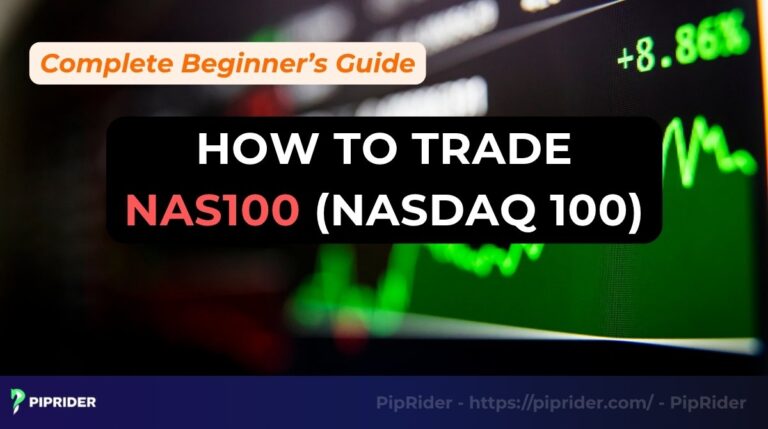How can you distinguish between a powerful, sustainable trend on EUR/USD and a fleeting price spike that’s about to collapse? The guppy multiple moving average (GMMA) is a brilliant visual instrument designed to answer that very question, helping traders to see the complete picture of market psychology and trend vitality.
This guide serves as a definitive manual for the GMMA, moving beyond abstract theory to provide actionable, Forex-centric strategies for immediate application.
Key Takeaways
- Guppy Multiple Moving Average (GMMA) visualizes market sentiment using two groups of moving averages.
- Wide separation between the two groups signals a strong, healthy trend.
- The long-term (red) group of MAs defines the primary, underlying trend direction.
- The highest-probability trade is buying a pullback of the short-term group into the long-term group.
- This indicator is a lagging, trend-following indicator designed to follow trends, not predict reversals.
1. What is the guppy multiple moving average (GMMA)?
The Guppy Multiple Moving Average (GMMA) is a technical analysis indicator that uses twelve separate exponential moving averages (EMAs) to identify the direction, strength, and health of a market trend. This indicator works by visually separating the behavior of short-term traders from that of long-term investors. These two components are shown on the chart below:

Daryl Guppy, a renowned Australian trader and author, created the powerful Guppy Multiple Moving Average (GMMA) indicator, first detailing its concept in his 1996 book Trend Trading (Guppy, 1996). According to sources such as Investopedia, the GMMA was not merely intended to generate simplistic crossover signals; rather, it was designed to help traders interpret market psychology and understand the consensus between short-term speculators and long-term investors (Investopedia, 2008).
By plotting two distinct groups of moving averages, the GMMA provides a unique window into the market’s structure. A trader can instantly see if a trend is driven by short-term speculation or supported by the conviction of long-term institutional money. This insight is what makes the GMMA an invaluable tool for any serious trend-follower.
Conceptually, it shares some DNA with the alligator indicator, which also uses multiple smoothed averages to identify market phases. However, the GMMA expands on this by distinctly visualizing the battle between short-term speculators and long-term investors.
2. The components of the GMMA indicator
The Guppy Multiple Moving Average is built from two core components, each represented by its own group of exponential moving averages (EMAs). The brilliance of the indicator lies in how it intentionally divides these twelve EMAs into two distinct sets.
This separation is the key to unlocking the indicator’s analytical depth, as each group represents a different psychological force within the market: the fast-moving traders and the slow-moving investors.
As you can see on the chart, the 12 EMAs are split into two groups.

2.1. The short-term “Traders” group (fast MAs)
The first component is a group of 6 short-term EMAs, using the common periods of 3, 5, 8, 10, 12, and 15-day EMAs. Think of this “blue” band on your chart as representing the fast-moving, speculative players. They react quickly to daily news and the volatility of major Forex sessions like the London or New York open.
2.2. The long-term “Investors” group (slow MAs)
The second component consists of 6 long-term EMAs with periods of 30, 35, 40, 45, 50, and 60-day EMAs. This “red” band on your chart reflects the market sentiment of the “deep-pocketed money”, the large institutions, banks, and funds. Their actions establish the underlying, more stable current of a currency’s trend.
3. The GMMA indicator’s formula
Unlike complex oscillators, the GMMA’s power does not originate from a single, convoluted mathematical equation. Instead, the indicator is built from a foundational and widely trusted element of technical analysis. Its true strength lies in the visual interpretation of its components.
- EMA formula: The GMMA is formed by plotting 12 individual Exponential Moving Averages (EMAs), each calculated with the standard formula:
EMA = (Current Price – Previous EMA) * Multiplier + Previous EMA
Multiplier = (2 / (Lookback Period + 1))
- Short-term group: This consists of EMAs with periods 3, 5, 8, 10, 12, 15.
- Long-term group: This consists of EMAs with periods 30, 35, 40, 45, 50, 60.
While manual calculation is unnecessary, understanding that the indicator is built from EMAs is key to appreciating its role as an instrument for analyzing trend and momentum.
4. Forex trading strategies with the GMMA
Now we transition to practical application, where theory becomes trading decisions. Reading the GMMA is the art of observing the interplay between the two colored bands, as their relationship reveals everything you need to know about a trend’s health, direction, and strength.
4.1. Decoding the trend and assessing its vitality
Before entering a trade, you must first learn to “diagnose” the market’s current state. The GMMA offers three vital visual clues: the expansion, compression, and relative positioning of the two bands, which together create a full picture of the trend.
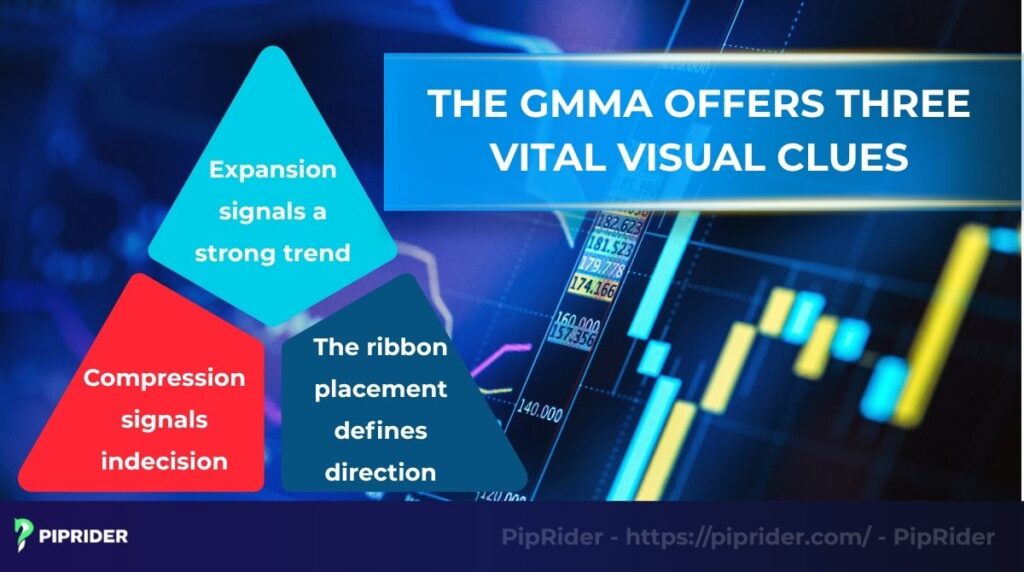
- Expansion signals a strong trend: When the long-term red band begins to spread apart and widen on a GBP/USD chart, the widening space serves as a powerful visual confirmation that long-term investors are in strong agreement. Such an expansion signifies that the underlying trend is robust and healthy.
- Compression signals indecision: When the two bands of moving averages squeeze into a tight cord on a pair like AUD/NZD, the action is a clear warning that the market lacks direction. A compressed state indicates a sideways market or a potential trend change, signaling a time for caution.
- The moving average ribbon placement defines direction: The orientation of the two ribbons tells you the trend’s direction. On a USD/JPY chart, if the short-term blue band is trading cleanly below the long-term red band, the dominant trend is down. Your focus should only be on selling opportunities.
To make identifying these opportunities even clearer, here is a quick summary of the key signals from the GMMA.
| Signal | Description | Market condition |
| Buy signal | The short-term blue band makes a crossover decisively above the long-term red band. | A new uptrend is emerging or a strong downtrend may be reversing. |
| Buy on pullback | The short-term blue band dips into the long-term red band but quickly “curls” back up without crossing below. | The dominant uptrend is healthy, and a short-term correction is ending. |
| Sell signal | The short-term blue band makes a crossover decisively below the long-term red band. | A new downtrend is emerging or a strong uptrend may be reversing. |
| Sell on pullback | The short-term blue band rallies into the long-term red band but quickly “curls” back down without crossing above. | The dominant downtrend is healthy, and a short-term correction is ending. |
| No signal | Both the blue and red bands are tangled, compressed, and moving horizontally. | The market is consolidating or in a ranging phase. Avoid trading. |
Read more:
Trading Strategies Using Continuation Candlestick Patterns
Trading the Thrusting Candlestick Pattern
4.2. Strategy 1: The trend-following pullback
Trading pullbacks using the GMMA is widely regarded as the most dependable and effective methodology. It is designed to get you into an established trend at a better price action, aligning your entry with the institutional flow after short-term speculators have taken profits.
- Case study: During the first week of June 2024, the EUR/USD H4 chart showed a clear uptrend, confirmed by a wide, upward-sloping red “investor” band. Following the ECB’s rate decision, short-term traders took profits, causing the blue “trader” band to dip into this red ribbon. While a novice might see this as a reversal, the red ribbon remained strong, signaling that long-term sentiment was still bullish. This confirmed the presence of bullish conditions. The buy signal occurred when the blue band “curled” back up and out of the red group, indicating the pullback was over.
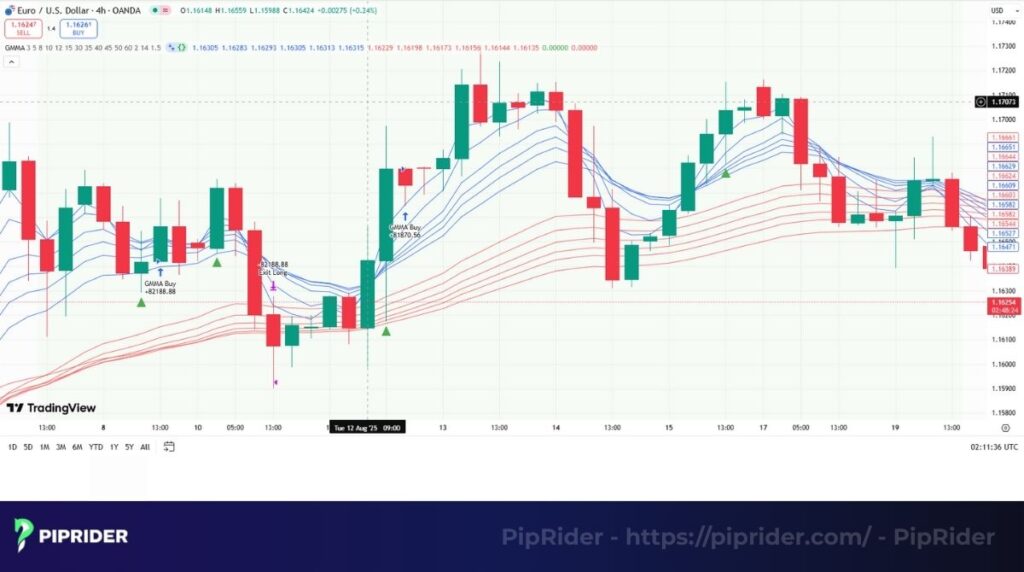
This aligns with principles from market veterans like Linda Raschke, who, as featured in “The New Market Wizards,” considered the first pullback in a new trend prime trading opportunities (Schwager, 1992).
Visually, this corrective phase often forms a classic structure on the price chart. Integrating flag pattern trading rules here—such as waiting for a clear trendline break—adds a precise mechanical trigger to the GMMA’s visual confirmation.
4.3. Strategy 2: The for new trends
The strategy is built to get you into a new trend as a clear consensus emerges between the two market groups. While it offers greater reward potential by capturing the beginning of a move, it carries more risk than a standard pullback trade.
- The setup: Look for a currency pair that has been in a long-term downtrend or a sideways market. On the GMMA, such a market state is shown by the blue band being below or tangled with the red band. The key is to find a point where both bands have become flat and tightly compressed, signaling the prior momentum has vanished.
- The signal: The entry signal happens when the entire group of short-term blue MAs makes a decisive move from below to above the entire group of long-term red MAs. A “full-group signal” of this nature on a key timeframe like the H4 suggests a fundamental shift in market psychology, offering an early chance to join the new trend.
4.4. Strategy 3: The compression breakout
The compression breakout strategy is specifically designed for trading periods of anticipated high volatility, such as major news events. It uses the GMMA’s compression as a visual cue that the market is storing energy for a powerful, imminent breakout.
- The setup: Look for a period where a currency pair is consolidating, often before a high-impact event like Non-Farm Payrolls. The GMMA represents this consolidation phase with its blue and red bands squeezing tightly together and moving horizontally. Think of this compression like a coiled spring: the tighter it gets, the more powerful the eventual release of energy will be.
- The signal: Observing this compression is your cue to prepare for a breakout. A trader can place pending orders (a Buy Stop above the recent high and a Sell Stop below the recent low) to capture the powerful move that almost always follows when the news hits and the bands explode apart. This scenario is what defines sideways conditions before a breakout.
4.5. Strategy 4: The cross-confirmation trade
The cross-confirmation strategy combines the GMMA with Fibonacci Retracement and the RSI (Relative Strength Index) to find high-probability trade setups. The goal is to enter a strong trend precisely when a pullback ends at a key confluence of these three tools.
- GMMA: First, confirm a strong trend where the long-term red band is expanded and angled sharply. Wait for a pullback, which is visualized by the short-term blue band dipping into the red band.
- Fibonacci: On this pullback, draw a Fibonacci Retracement. The ideal signal is when the blue band’s retreat ends near a key level like the 50% or 61.8%.
- RSI: Simultaneously, check the RSI. A buy signal is confirmed if the RSI has dipped below 50, showing the pullback’s momentum has faded.
A confluence of a strong trend, a pullback to a Fibonacci level, and fading momentum on the RSI creates a precise, high-probability entry to rejoin the main trend.
5. What is the difference between GMMA and EMA?
The fundamental difference between the GMMA and a single EMA is not about complexity, but about the depth of information each tool provides. A single moving average offers a one-dimensional view of the trend; the GMMA, in contrast, delivers a multi-dimensional picture of the market’s underlying psychology.
Let’s break down this difference in detail.
5.1. The difference in analytical depth
A single moving average, like the 50 EMA, only provides one piece of information: the average price. While useful for seeing the general trend, a single line offers zero insight into the trend’s character or the conviction behind it.
The GMMA, in stark contrast, provides a multi-dimensional view by separating the market into its two core psychological groups. The long-term (red) band reveals the underlying conviction of investors, while the short-term (blue) band shows the real-time sentiment of traders.
Observing the interaction between these two bands allows a trader to instantly distinguish between minor profit-taking and a major trend reversal. The difference is like seeing a single data point versus understanding the full story.
5.2. A direct comparison of the two tools reveals
Let’s break down the key differences to understand why the Guppy Multiple Moving Average (GMMA) offers a far richer perspective than a single Exponential Moving Average (EMA).
| Characteristic | Single Moving Average | Guppy Multiple Moving Average (GMMA) |
| Information Provided | A single data point (the average). | A relationship between two groups. |
| What it Shows | General price direction. | Direction, strength, conviction, and volatility. |
| Psychological Insight | None. | Visualizes trader vs. investor behavior. |
| Best Use | Simple trend identification. | In-depth trend analysis and qualification. |
In essence, a single EMA tells you where the average price is. The GMMA tells a deeper story, explaining why a particular price is behaving as it does by visualizing the dynamic relationship between the two most dominant forces in any market. This is the difference between seeing a number and truly understanding the narrative behind it.
5.3. A practical example: Analyzing a pullback
Let’s consider a scenario where the price action is in an uptrend and starts to retrace.
- With a single 50 EMA: One might see price drop and touch the 50 EMA line. This presents a potential buy signal. However, you are left with critical questions: Is this a healthy pause in a strong trend, or is the trend weakening and about to reverse? The single line gives no further clues.
- With the GMMA: You see the same price drop. Yet, the GMMA shows that only the blue “surface” ribbon has dipped, while the red “main current” group remains wide, parallel, and angled strongly upwards, signaling unwavering institutional support. This reveals that the pullback was caused only by the short-term blue ribbon compressing and dipping into the red one.
This tells a complete story: the long-term players are holding firm, and the dip is merely short-term profit-taking or a reaction to minor news. The moment the blue band starts to expand and “curl” back in the direction of the red band, it signals that the speculators are now re-aligning with the institutions. This is a far richer, higher-probability signal than a simple price-touching-a-line event.
6. Pros and cons of the GMMA
Like any specialized indicator, the GMMA has environments where it excels and others where its signals become less reliable. A professional trader must understand both to apply it effectively.
Here is a quick summary of its key advantages and limitations.
| Pros | Cons |
| Superior trend qualification: Excels at showing the health and conviction behind a trend, not just its direction. | Inherent lag: As a lagging indicator, it confirms trends after they start, never predicting the exact top or bottom. |
| Clear psychological insight: Provides a unique visual representation of the dynamic between short-term traders and long-term investors. | Ineffectiveness in ranging Markets: Generates frequent and confusing signals when the market is choppy and lacks a clear direction. |
| Effective noise filtration: The long-term band helps to filter out insignificant short-term price swings, allowing a trader to hold onto a strong trend. | Lack of precise signals: Functions as an analysis tool for context, not an execution tool for exact entry or exit points. |
Read more:
Cup And Handle Pattern: Definition, Strategies & Target
Hikkake Pattern Explained: Complete Guide for Traders
7. Tips for trading with the GMMA effectively
Successful application requires adhering to a few professional guidelines. These tips will help you leverage the GMMA indicator’s strengths and avoid common pitfalls.
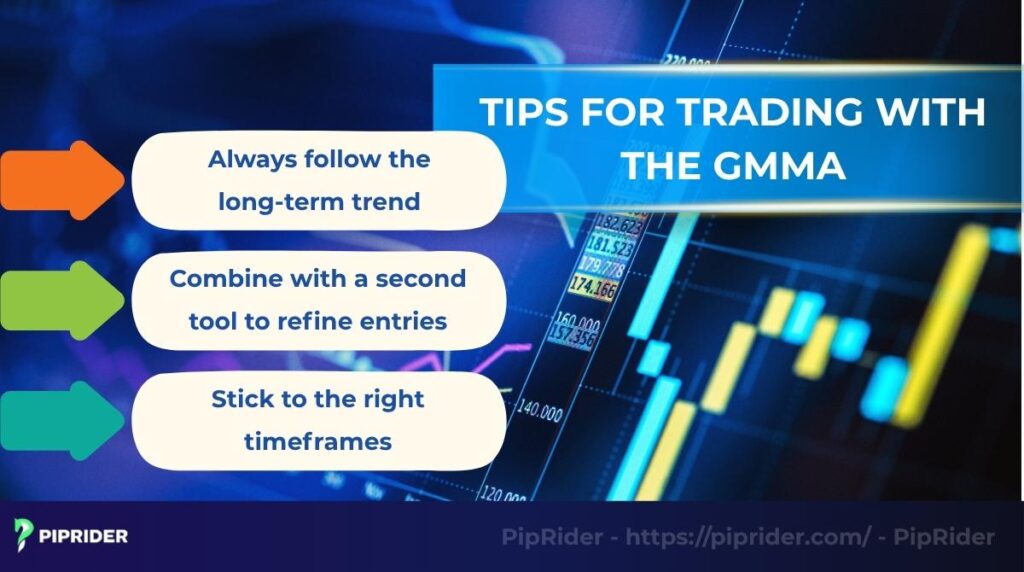
- Always follow the long-term trend: The red band acts as a non-negotiable compass. This group of moving average ribbon establishes the true, underlying trend. The single most important rule I’ve learned is to never place a trade that opposes the red band’s direction. Ignoring this principle can lead to costly mistakes, as doing so means fighting against the institutional flow.
- Combine with a second tool to refine entries: While the GMMA provides excellent market context, combining the indicator with a secondary tool can greatly improve entry timing. For instance, during a pullback into the red band, using an oscillator like the RSI to confirm an oversold condition provides a powerful confluence. Such a combination helps to filter out false signals and allows for a more precise entry.
- Stick to the right timeframes: In my professional experience, the GMMA’s reliability is highest on the H4 and D1 timeframes where it excels at identifying major trends. Attempting to use the indicator on lower charts like the M15 often results in excessive noise and conflicting signals, which can lead to poor decisions. The GMMA is a tool for seeing the big picture, not for scalping.
8. How to set up the GMMA on MetaTrader 4 or 5
Fortunately, adding this indicator to your charts on a powerful trading platform like MetaTrader 4 or 5 is a very simple process.
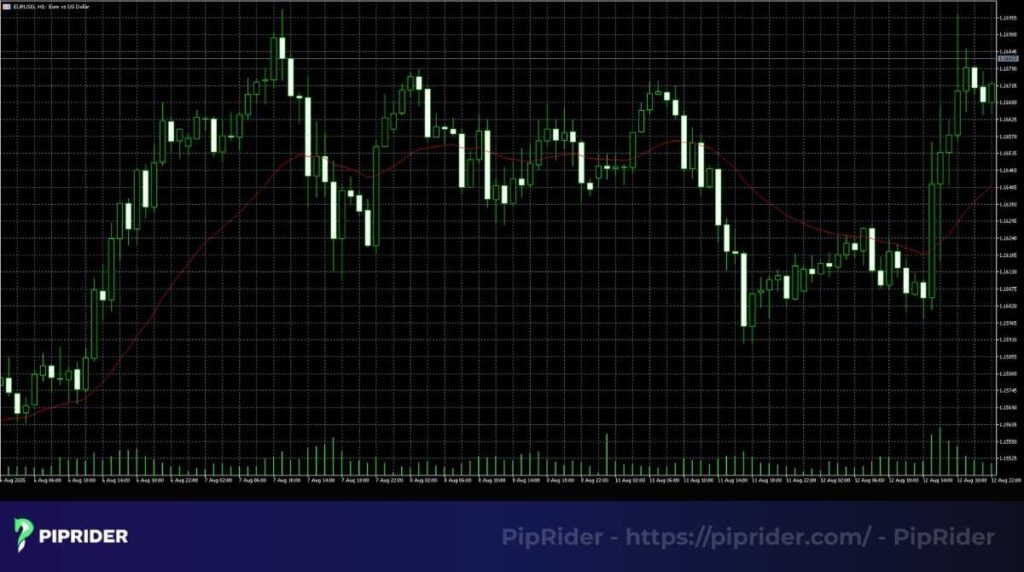
- Open your MetaTrader 4 or 5 platform.
- In the “Navigator” window on the left side of your screen, find the “Indicators” list.
- Expand the “Custom Indicators” folder. (If you don’t see the GMMA listed, you may need to download and install a custom indicator file first.)
- Find “Guppy Multiple Moving Average” in the list.
- Double-click the indicator or drag it directly onto your chart.
- A settings window will appear. You can adjust the colors and parameters as needed, then click “OK.” The moving average ribbon will then be displayed on your chart.
9. FAQs
10. Conclusion
The Guppy Multiple Moving Average is a unique and insightful trend analysis tool, perfectly suited for traders who wish to understand the deeper psychology of the Forex market. It moves beyond simple price analysis to visualize the consensus, or lack thereof, between short-term speculators and long-term market participants.
The key to success with the GMMA is concentrating on the relationship between the two groups of moving averages to accurately assess the health, strength, and direction of a trend.
Want to discover more trading indicators? Check out Piprider’s useful articles in our Best Technical Indicators category.








